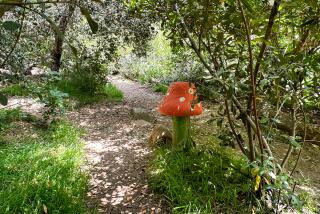Zoo Blooms as Botanical Garden
Lions, and tigers, and palm trees, oh my.
The plants at the Los Angeles Zoo still play second fiddle to the animals. But the zoo’s extensive collection of plants has won it a new accreditation--as a zoo and botanical gardens from the American Assn. of Museums, announced Mayor James K. Hahn and zoo officials Thursday.
The horticulturists see the botanical collections as having a purpose loftier than making the zoo a green and pleasant place.
“A zoo is the only place in the world where animals from every continent and plants from every bio-region and people from every walk of life and culture come together on a daily basis,” said T.H. Culhane, horticulture data specialist. “The zoo is the only place in L.A. where this happens. What we model here is a vision of a harmonious world, some would say a Utopian vision.”
Peer review is part of the accreditation process, as is evaluation of a study prepared by the institution, according to the American Assn. of Museums, which has accredited about 750 institutions nationwide.
Karen Sausman, president of the Living Desert Garden and Zoo in Palm Desert/Indian Wells, was one of two people to evaluate the zoo and its botanical gardens for accreditation.
“We found something extraordinarily admirable,” Sausman said: The zoo’s horticulture staff, working with volunteers, developed a computer program, and used it, along with global satellite positioning technology, to catalog and map all 7,500 plants at the zoo. Now the zoo can instantly update its computerized database and create accurate maps of all its plant life.
“It’s probably the most sophisticated plant-mapping system I’ve seen in a botanical collection,” Sausman said. “A very important part of managing a botanical garden is knowing what you’ve got and where it is.”
She also lauded the park for sharing its innovative technology and database with other institutions.
The zoo spends about $1.3 million a year on its botanical gardens, most of it for salaries for about 30 staff members. Its plant-related expenses last year included $40,000 for tree-trimming, a zoo spokesman said.
Even with money and a sophisticated database, gardening in a zoo is no walk in the park, according to Edward Melara, senior maintenance supervisor.
“We have large crowds coming through the zoo, and a lot of times they trample on plant material,” he said. Last year, 1.4 million people visited.
Whenever possible, the staff uses plants that reflect the natural habitat of the animals, zoo horticulturist Janica Jones said.
To help keep visitors from getting lost, there are “indicator plants” for each of the zoo’s five main areas--Australia, North America, Africa, Eurasia and South America.
An African flowering shrub known as lion’s tail is the indicator plant for the African section. If you spot the shrub, you know the chimps and lions are nearby.
Also when possible, the zoo uses nonchemical pest control. “The peacocks help with the snails,” said D.J. Smetana, park maintenance supervisor.
The zoo has a number of rare plants, including two 60-foot Chilean wine palms. Rare plants keep arriving because the zoo is an official plant rescue center for the U.S. Department of Agriculture. Whenever plants are confiscated at LAX or elsewhere, they are sent to the zoo or another center for safekeeping. Often, they remain, Jones said.
Recently, the zoo got a large collection of confiscated South African succulents.
“We’ve also been getting a lot of cycads lately,” Jones said.
Cycads are ancient, primitive plants, explained Culhane: “Universal Studios uses them in the Jurassic Park attraction. When you want to say dinosaurs, you use cycads.”
Melara said he and his staff try to keep the plants looking good but natural. The zoo has stopped skirting its Mexican fan palms, or removing the grass skirt of dry material that hangs from the top.
In its botanical database, the zoo keeps track of plants that are appropriate food for the animals, called foraging plants. But mixing plants and animals is always a tricky business, the staff said.
Plants that are potentially toxic to a particular animal are kept at a safe distance.
The staff also looks for plants that are compatible with specific animals. Thanks to the Paris Zoo, the L.A. facility recently got access to botanical data collected by 67 European zoos. As a result, it has learned that camels live nicely with elderberry and that swamp wallabies don’t mind black walnut trees.
But some plants and animals don’t mix. Smetana recalled the staff’s frustration in planting the black bear exhibit. They used only plants found in the bear’s natural habitat, including sequoias and cedars.
“We went in and made it beautiful,” he said. “It looked like you were standing in Yosemite.”
Not for long. Within two weeks, the bears had battered the saplings into oblivion. After three tries, the staff gave up and covered the floor of the exhibit with redwood chips.
The zoo has a garden full of native plants near its entrance to encourage the public’s use of indigenous, drought-tolerant plants at home.
“The zoo has an enormous impact on families and kids on what the environment can be,” Culhane said.
For her, Jones said, “the satisfaction [in tending the zoo’s plants] comes from making it a better place for the animals and the visitors.”


